Trenton Patterson is committed to a big project to reduce food waste.
Trenton Patterson, the eighth grader at John Glenn Middle School in Indio is an example of a community-minded teenager concerned about the world around him.
Trent noticed that many of his classmates walked out of the cafeteria with their tray of food in-hand, turned, and threw away the whole fruit or pre-packaged veggies and/or fruit before even making it to the table. He discussed the situation with his mom, a Desert Sands Unified School District nurse. Was there a way to collect the unused food for distribution to those in need?
John Glenn Middle School is part of the International Baccalaureate Program (or Programme as it is spelled in the nearly 5,000 other schools throughout the world). As indicated on their website (www.ibo.org) “The IB enables students to direct their own learning pathway and develop the skills and confidence they need to thrive and make a lasting difference.” DSUSD has four IB schools – Amelia Earhart Elementary School, Benjamin Franklin Elementary School, John Glenn Middle School, and La Quinta High School. The elementary schools are part of the Primary Years Programme (PYP) and the high school has both the Diploma Programme and the Career-Related Programme (CP). Each has unique curriculum and requirements. John Glenn Middle School is a part of the Middle Years Program (MYP) that emphasizes intellectual challenge. The culmination of middle school in the IB Programme is an independent learning project incorporating an international look at the world. For Trent the prevention of food waste provided him the opportunity to focus on a program in his scope of influence that could change his peers’ way of looking at the problem while also fulfilling his MYP project requirement.
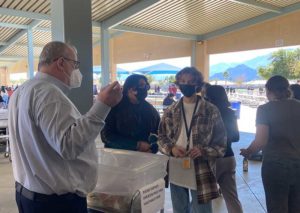
DSUSD Director of Nutrition Services Dan Cappello
The first call that Trenton made was to DSUSD Director of Nutrition Services Dan Cappello. The two met and came up with a plan. Dan looked into the health requirements for the redistributing of food and was able to work with Trent to narrow down the focus to include whole fruit (apples, oranges, bananas) and packaged vegetables and fruit. The nutrition services team prepares such items as lidded-cups of grapes and broccoli, among others, for distribution to students.
School cafeterias must follow strict government guidelines including a requirement that students going through the lunch line must take a meat or meat alternative, a grain/bread, a fruit, vegetables, and milk. Each student must take three items from separate groups and one of the three must be a serving of fruit or vegetables. As Cappello explained, “One of the things that’s very difficult for students to understand, and somewhat difficult for me to explain, is that students are forced to take the fruit and/or vegetables as part of their meal. It is a federal regulation. So when they take the food from the cafeteria and they don’t want to eat it, they throw it in the trash. Trent set up this program so that he can recollect the food and donate it to needy families in the Coachella Valley.”
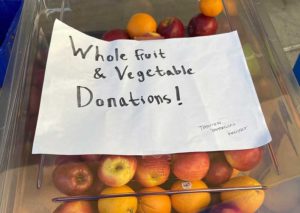
Fruit and vegetable donations to needy families in the Coachella Valley.
The support at the school has been tremendous. The nutrition service workers at the Glenn campus provided the bins for Trent to use and help monitor the program. The staff who monitor lunchtime at the school are on board and the security agents assigned to JGMS have embraced the program as their own as well.
Assistant Principal Andrea Guaydacan commented, “I think it is amazing. I’m so proud that one of our students is reaching out to the community that way. That’s something we definitely promote here as part of our IB program. And it’s been amazing seeing the other students respond. We just walked around one day and told the kids about it and they are now making sure that they take their fruit over to the donation boxes.”
School custodian Susie Vasquez also weighed in noting, “I think it’s the best idea because everybody should have something to eat and students would normally throw it away.”
Students, too, provided comments such as “it’s cool!” “it’s a good idea.” “We’re not wasting fruits and vegetables” and “everybody should have something to eat”.
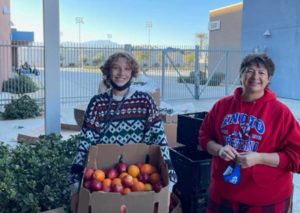
Trenton Patterson with Victoria Shatavyzadeh
Trent’s second call was to Indio High School’s Victoria Shatavyzadeh. Her main duties include teaching life skills, study skills, career exploration, and a very special program that she calls Excel. Her special needs students produce tee shirts and logoed items for sale throughout the school and help her manage the collaboration with FIND Food Bank. She worked with Trent and the fruit and vegetables he collects are brought to Indio High School where FIND Food Bank operates a twice-weekly distribution center.
What’s next for Trenton? At a recent farmers market held at his school he had a booth located among the stalls with fruit and veggies and he discussed food waste with his fellow Redhawks. The cooperation of other students is vital to the successful project and it is clear that the school has taken on the project along with Trent. He will continue to work with Dan and Victoria to develop a sustainable plan for both his school and others. In the spring, he will present his project at a school-wide exhibition knowing that he has met the criteria of the MYP IB Programme.
Trent closed his interview for this article by saying, “I started by thinking small but it is the helping hands that grew the project, allowing me to do even more.”
Image Sources
- Trenton-Discusses-Food-Waste-800×568-1: DSUSD

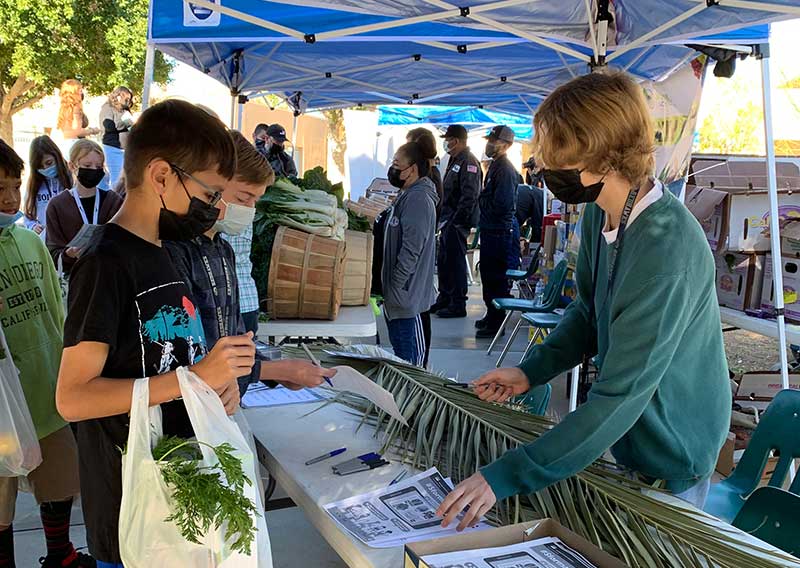
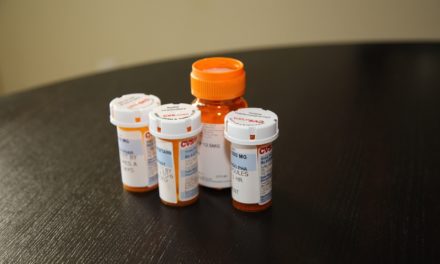

![Enrolling Now, Rewarding Careers Ahead [Sponsored]](https://ukenreport.com/wp-content/uploads/2024/04/COD_heroes_1-1385-2-440x264.jpg)


